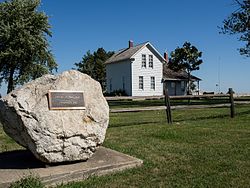| Catalpa | |
| U.S. National Register of Historic Places | |
 | |
  | |
| Location | Southeast of Greenfield, Iowa |
|---|---|
| Coordinates | 41°13′55″N 94°21′37″W / 41.23194°N 94.36028°W / 41.23194; -94.36028 |
| Area | 200 acres (81 ha) |
| NRHP reference No. | 74000776 |
| Added to NRHP | November 13, 1974 |
Catalpa, generally known as Wallace Farm, is a historic farm located near the small city of Orient, Iowa, United States. It is associated with Henry Cantwell Wallace, who owned and operated the influential agricultural publication Wallaces' Farmer, and served as U.S. Secretary of Agriculture (1921-1924). It is also associated with his son, Henry Agard Wallace, who followed his father at the newspaper and served as U.S. Secretary of Agriculture (1933-1940), Vice President of the United States (1941-1945) and U.S. Secretary of Commerce (1945-1946). He was the Progressive Party candidate for president in 1948. This was one of several farms owned by the Rev. Henry Wallace, Henry Cantwell's father. It was acquired by the family in 1877, and it was operated by a tenant farmer until Henry "Harry" Cantwell took it over. His son, Henry Agard, was born here in 1888. After five years, Harry returned to his studies at Iowa State University in Ames and the family left the farm at that time.
Catalpa was listed on the National Register of Historic Places in 1974 (as "southeast of Greenfield). The designation includes the farmhouse and outbuildings, which are modest frame structures with gable roofs, and a 200-acre (81 ha) plot of farmland. The house and barn were built before the Wallaces moved here in 1887.
Description
The house consists of a two-story rectangular structure with a smaller, one-and-a-half-story rectangular wing. Notable features include the paired windows on the second floor of the main section and a shed-roof porch supported by posts extending from the smaller wing. The original clapboard exterior has been replaced with asbestos shingles, while the roof retains what appear to be original wooden shingles. The extent of interior modifications remains uncertain, but they are believed to be minimal and characteristic of typical updates made to modest farmhouses. The house received a new foundation in 1961.
Located further from the farmhouse, within the original 200-acre Wallace Farm, are the original barn and various outbuildings. The barn’s wooden vertical siding is significantly deteriorated.
Significance
This farm holds significant historical value because it is tied to the achievements of two influential Iowa figures in agriculture and politics. Henry Cantwell Wallace owned and edited Wallaces Farmer, a prominent agricultural publication, and served as the U.S. Secretary of Agriculture from 1921 to 1924. After his passing in 1924, his son, Henry Agard Wallace, took over the newspaper and went on to have a distinguished career, serving as the U.S. Secretary of Agriculture from 1933 to 1940, Vice President of the United States from 1941 to 1945, Secretary of Commerce from 1945 to 1946, and running for president under the Progressive Party in 1948.
This farm was one of several properties that Henry Cantwell Wallace’s father acquired in Adair County between 1869 and 1887, initially leased to tenants. In 1877, Reverend Henry A. Wallace moved to Winterset, Iowa, leaving the ministry to oversee these properties. It wasn’t until 1887 that the Wallace family began directly managing this particular farm. At that time, Henry C. Wallace, who had become disinterested in his studies at Iowa State Agricultural College, persuaded his father to let him run the farm. After managing the property for five years and welcoming the birth of his son Henry Agard, Henry C. returned to school to complete his degree and joined the faculty until 1895. The family's focus later shifted to their newspaper venture in Des Moines, though Henry C. continued to own a 280-acre farm near the city in 1924, with Henry A. owning an adjacent 40-acre plot.
By 1916, Wallaces Farmer had established itself as a leading agricultural publication, known for its advocacy against monopolistic practices and its focus on economic issues in agriculture. The farm is a key part of the Wallace family's story, representing their early experiences and the foundation for their later contributions to agriculture and national policy.
See also
The following properties are associated with the Wallace family and are all listed on the National Register of Historic Places:
References
- ^ "National Register Information System". National Register of Historic Places. National Park Service. March 13, 2009.
- ^ Joseph R. Hamilton. "Catalpa". National Park Service. Retrieved 2016-08-07. with photos
| U.S. National Register of Historic Places | |
|---|---|
| Topics | |
| Lists by state |
|
| Lists by insular areas | |
| Lists by associated state | |
| Other areas | |
| Related | |
| National Register of Historic Places in Adair County, Iowa | ||
|---|---|---|
| Adair |  | |
| Greenfield | ||
| Stuart | ||
| See also: National Register of Historic Places listings in Adair County, Iowa and List of National Historic Landmarks in Iowa | ||
This article about a building or structure in Iowa is a stub. You can help Misplaced Pages by expanding it. |
This article about a property in Adair County, Iowa on the National Register of Historic Places is a stub. You can help Misplaced Pages by expanding it. |